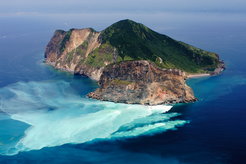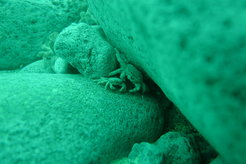Foraging under Extreme Events
Hydrothermal vent animals adapt differently to drastic biogeochemical disturbance
The extreme, toxic conditions of ocean hydrothermal vents are similar to those when life first emerged on Earth 3.5 billion years ago. Studying animals living in these vents can teach us how life adapts to extreme environments. Hydrothermal vents also serve as natural laboratories for how animals in the sea respond to sudden and unpredictable disturbances. Understanding such responses is now more important than ever because of global climate change and human exploitation of these unique geological systems.

In 2016, the shallow hydrothermal vents at Kueishantao off the coast of Taiwan – one of the most well studied vent systems in the world – were hit by two consecutive extreme events: an earthquake and a subsequent typhoon. These disturbances caused a drastic reduction in vent activities, disrupting the food base for many vent animals.
A new publication led by researchers from the Max Planck Institute of Geoanthropology used biogeochemical tracers to study how these extreme events impacted foodwebs in the hydrothermal vents. The researchers focused on two populations: the endemic vent crab (Xenograpsus testudinatus) and non-endemic mollusk species.
The vent crab has been spotted in only three hydrothermal systems in the world. It is highly adapted to the toxic and acidic hydrothermal vent environment. The non-endemic mollusk species, on the other hand, are less picky eaters, a trait that helps them to live in a wider range of geographic locations.

The results of the study show that not all vent-dwelling species were equally resilient. The vent crab population, highly reliant on the diminished supply of sulfur bacteria, which derive their energy from chemical reactions in the vents, decreased rapidly after the extreme events. This suggest that vent crabs are much more closely associated with the hydrothermal vent sources than previously recognized. In contrast, the non-endemic mollusk species coped much better. Their population abundance and body sizes remained the same before and after the disturbance, probably because they were able to shift their diets to rely on phytoplankton, which are fed by sunlight.
These findings show that marine endemic species are more vulnerable to drastic biogeochemical changes than non-endemic species. The results are also a reminder of the potential ecological consequences of deep-sea mining and industrial dredging of the sea floor.

